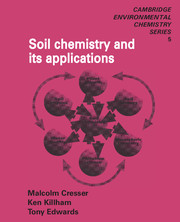6 - Soil chemistry and freshwater quality
Published online by Cambridge University Press: 05 August 2012
Summary
One of the many vital roles played by soil is its function as a buffer regulating the quality of water in rivers and lakes and, to some extent, groundwaters. In the majority of catchments, unless outcropping rock is dominant, precipitation interacts to a substantial degree with soil. The precise fate of incoming precipitation, i.e. the pathway it follows through or over soil to a drain, stream or lake, depends upon the physical characteristics of the soil, the quality, duration and intensity of precipitation, prior climatic conditions, surface and subsurface topography, and the physical form of the precipitation (e.g. rain, hail, snow, mist etc.). The hydrological pathway followed, in turn, governs which zone or zones of the soil the water interacts with en route to open surface water or groundwater. The purpose of this chapter is to consider briefly how the interactions between draining water and the soil biota, atmosphere, minerals and organic matter ultimately influence water quality in natural ecosystems. We will then be in a better position to see how these natural processes cope with human activities such as modern agricultural and forestry practices and with pollution generally. The way in which the soil/water system copes with pollutants of other origins is discussed in Chapter 7.
Drinking water must be acceptable with respect to taste, colour, microorganisms, salinity, acidity and concentrations of organic pollutants, toxic heavy metals, aluminium, nitrate and nitrite.
- Type
- Chapter
- Information
- Soil Chemistry and its Applications , pp. 128 - 150Publisher: Cambridge University PressPrint publication year: 1993



